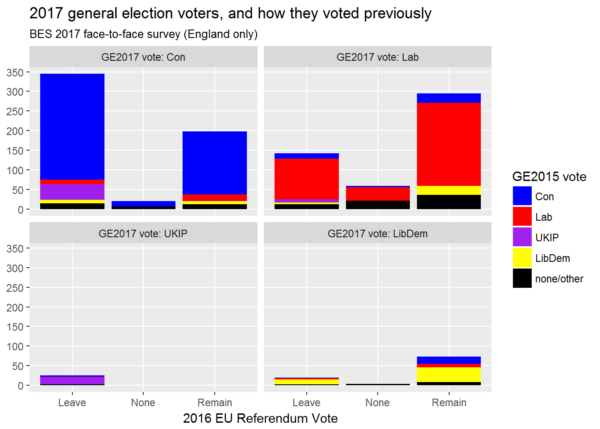This is the third and final part of my preliminary analysis of groups of voters defined by the choices they made in the 2015 general election, the 2016 European Union membership referendum, and the 2017 general election (c.f. Stephen Bush’s nine voter groups), using an English subset of responses to the British Election Study’s post-election face-to-face survey. In the first part, I looked at the ten largest groups, from Conservative-Leave-Conservative to Conservative-Remain-Labour, both in terms of their size and in terms of their self-declared likelihood to vote for various parties in future, and found that Labour Remainers were not only more numerous but (on their own assessment) more likely to be poached than Labour Leavers, while the smaller group of Conservative Remainers who had switched to voting Labour were quite likely to switch again. In the second part, I looked at six groups of voters who had in common that they could have voted but did not in the 2015 general election, finding that most of them did not vote either in the 2016 referendum or the 2017 general election, and that only the minority who voted Remain in the 2016 referendum were more likely than not to have voted in the 2017 general election.
To finish up for now, here’s a single chart showing all voter groups which participated in the 2017 general election (weighted by demographic group and by 2017 vote). Each quarter of the chart below shows the members of the sample who voted for one of the four main parties. These voters are further subdivided into columns to show how they voted in the referendum and into coloured blocks to show who they voted for in 2015 (note that black covers both non-voting and voting outside the four main parties, which most often meant voting Green as the data are from England only):
What does this chart tell us? It tells us that, at least within this random sample of 1874 voters (1777 after weighting)…
- Most of those who voted for the two right-wing parties in 2017 had voted Leave in 2016, while most of those who voted for the two liberal-left wing parties in 2017 had voted Remain – and this is true whether we focus on voters retained or on new voters gained
- However, the Remainer proportion of the 2017 Conservative vote is substantially greater than the Leaver proportion of the 2017 Labour vote
- The Conservative Party picked up most of the (Leave-voting) UKIP vote from 2015
- But it picked up more votes from Labour Remainers than it did from Labour Leavers
- And so (less surprisingly) did the Liberal Democrats
- In fact, the Labour Party and the Liberal Democrats both picked up far more votes from Remainers than from Leavers – both from the Conservatives and from each other
- Those 2017 voters who did not vote in the 2016 referendum mostly ended up voting Labour
- Every party except UKIP both gained and lost a substantial proportion of voters between 2015 and 2017
- UKIP definitely lost voters, but you have to zoom into the chart to see its minuscule gains
To summarise: on the evidence of these data, the only really notable movement among Leavers seems to have been the metamorphosis of most 2015 UKIP voters into 2017 Conservative voters. Those voters are unlikely to go back to UKIP because, on the brink of financial ruin and with no credible leadership, UKIP is in no position to win them back. Otherwise, the movement that has taken place appears to have been largely among Remain voters: more Remainers than Leavers would seem to have gone in both directions between Labour and the Conservatives and between Labour and the Liberal Democrats, while the Liberal Democrats picked up a not inconsiderable number of formerly Conservative Remainers and while a larger block of Remain voters who had not voted for any of the four main parties in 2015 simultaneously fell into orbit around Labour.
The Labour and Conservative Parties did nothing to court the Remain vote last year, and have done nothing to court it since. But it looks like it’s the Remain vote that is volatile now.
